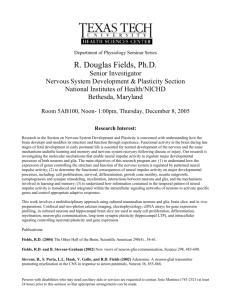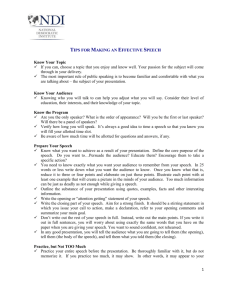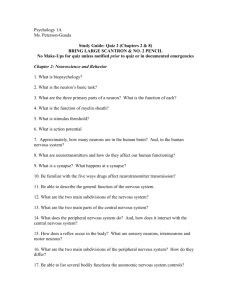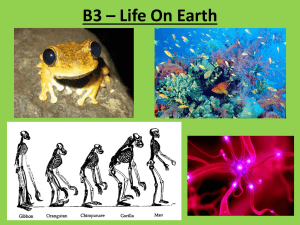Lecture_8_fill_in
advertisement
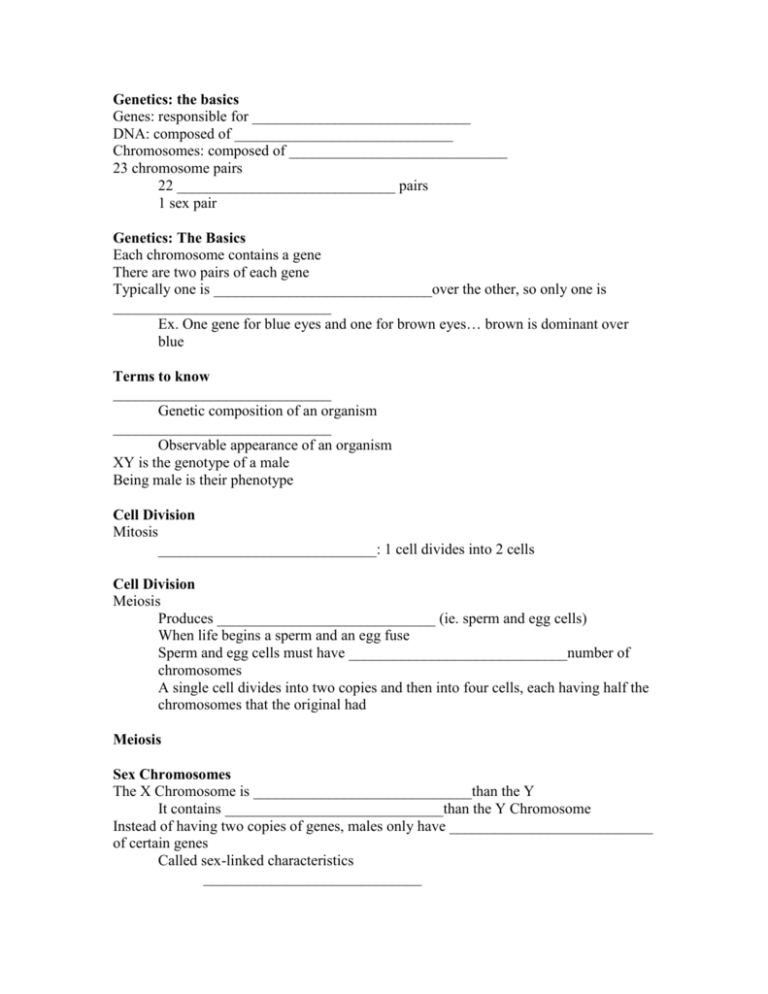
Genetics: the basics Genes: responsible for _____________________________ DNA: composed of _____________________________ Chromosomes: composed of _____________________________ 23 chromosome pairs 22 _____________________________ pairs 1 sex pair Genetics: The Basics Each chromosome contains a gene There are two pairs of each gene Typically one is _____________________________over the other, so only one is _____________________________ Ex. One gene for blue eyes and one for brown eyes… brown is dominant over blue Terms to know _____________________________ Genetic composition of an organism _____________________________ Observable appearance of an organism XY is the genotype of a male Being male is their phenotype Cell Division Mitosis _____________________________: 1 cell divides into 2 cells Cell Division Meiosis Produces _____________________________ (ie. sperm and egg cells) When life begins a sperm and an egg fuse Sperm and egg cells must have _____________________________number of chromosomes A single cell divides into two copies and then into four cells, each having half the chromosomes that the original had Meiosis Sex Chromosomes The X Chromosome is _____________________________than the Y It contains _____________________________than the Y Chromosome Instead of having two copies of genes, males only have ___________________________ of certain genes Called sex-linked characteristics _____________________________ _____________________________ What is all this DNA for? Through many steps, DNA is eventually _____________________________ Proteins are responsible for the _____________________________ Diversity Diversity is good! Adapted to _____________________________ Able to _____________________________ in environments Sources of diversity Crossing over of DNA _____________________________ Mutations Errors in the genetic code that occur _____________________________ Most mutations have _____________________________ Some mutations are _____________________________ Fragile X _____________________________Syndrome _____________________________Syndrome Fragile X syndrome Inherited _____________________________ Cause of autism Delay in _____________________________development Sex linked mutation Leads to the silencing of a portion of the _____________________________ Turner’s Syndrome Only one _____________________________ Only effects women Characteristics Short stature Lack of _____________________________development Webbed neck _____________________________ Arms that turn out at the elbow Down Syndrome Trisomy _____________________________ Cognitive development varies from mild to severe _____________________________is lagged Motor skills are _____________________________ Other increased risks: Down Syndrome Congenital _____________________________ (50% increase) Increased susceptibility to infection _____________________________problems Obstructive sleep apnea Thyroid dysfunctions (hypothyroidism) (20% increase) Acute myeloid leukemia, although their survival and relapse rate is much better than average _____________________________ (nearly absolute in males, fertility in females is possible) _____________________________ (80% increase) Eye problems (cataracts, strabismus, near and far sightedness) Alzheimer's disease Random fact X inactivation Females have _____________________________of the X chromosome Only 1 X chromosome is active The _____________________________can change within an organism _____________________________ So why do we talk about mutations in a biological psychology class? Deals with the biology of the brain Most evolutionary change has occurred _____________________________ Evolution has _____________________________of the human brain Evolution of the Nervous System Nervous systems are very _____________________________in the scheme of things Single cell organisms obviously didn’t have _____________________________ Animals with simple nerve nets _____________________________years ago First real nervous system with a brain _____________________________years ago True brains: chordates Evolution of the Nervous System The evolution of the brain The different parts of the brain are _____________________________ Fish have _____________________________that are larger than their cerebrum What about the evolving brain seems to matter? _____________________________? Seems to matter some _____________________________have huge brains What about the evolving brain seems to matter? _____________________________? Seems to matter some Chimp and human brains are fairly _____________________________ _____________________________have the most _____________________________ What about the evolving brain seems to matter? Jerison (1973) suggested that it is a ratio of _____________________________ __________________________________________________________ Evolution of the Human brain Very fast Within a few million years it _____________________________ Why so fast? Rapid human brain growth may have resulted from _____________________________ _____________________________and learning to plan for the future. Agriculture, _____________________________have not produced additional changes in brain size. The advantages of further increases in brain size may be offset by: _____________________________ the _____________________________required by the nervous system. How does the nervous system develop? Within a week of contraception _____________________________has 3 layers _____________________________ Forms skin and nervous tissue Mesotherm Forms _____________________________ (blood vessels, muscles) Endotherm Forms _____________________________ Nervous system development _____________________________from ectotherm Six stages: Formation of _____________________________ _____________________________of cells to their location _____________________________of neurons into types Formation of _____________________________between neurons _____________________________of particular neurons Rearrangement of neural connections Stages 1-2 First rapid cell division to form new _____________________________ Up to _____________________________ new cells per minute Next cells _____________________________ to their location Radial glia guide the migration Occurs in an _____________________________manner Inner layers are formed first Stages 3-4 _____________________________of cells into types Cells differentiate into glia or neurons The neural tube differentiates into _____________________________halves (for the peripheral nervous system) Other cells differentiate into spinal cord, _____________________________, and forebrain Formation of connections NOT random _____________________________to particular locations Development of the Nervous System Cell Death The nervous system _____________________________ All cells contain genes that program their death _____________________________ When activated these cells die Seems to be very important Lack of _____________________________has been shown to lead to _____________________________ Synaptic Pruning The nervous system overproduces the number of _____________________________ Within the first year of life, up to _____________________________may be eliminated Probably based upon _____________________________ Possibly a use it or lose it philosophy Effect of Experience on Development Life experience changes our _____________________________ Visual system Language When the _____________________________neurons are both active: the bond gets strengthened When one is active and the other is not: the bond gets ___________________________ The visual system: Development Remember the _____________________________gets input from different eyes Originally this is not the case Early in development, both eyes _____________________________ Connections from one eye is _____________________________and the connections from the other eye is _____________________________ Eventually only input from one eye is available Critical Periods Some development is contingent upon _____________________________ Language Learn it before _____________________________or cannot learn language at all _____________________________, the brain is unable to develop a proper language system Critical periods _____________________________ Birds think the thing they first see is their _____________________________ Human imprinting? Neglected orphans that formed connections to parents before age of _____________________________ fully recovered from deprivation Those that formed connections after 6 months, did _________________________ Plasticity Ability for the _____________________________ Can occur throughout life After strokes, most patients experience the _____________________________ Occurs because of programmed cells death, _____________________________, and the regrowth of synapses Stem cells Most cells in a full grown adult have _____________________________into their types These cells replicate, but if they are damaged, _____________________________can’t usually completely repair the damage Stem cells are _____________________________cells in the body Adults have them Fetuses as well Adult stem cells Most of them have “_____________________________” Ex. They can become any part of the liver, but cannot become part of the spleen Fetal stem cells have _____________________________ Can become part of any piece of the body Place in these cells to the damaged area, and healthy new cells replace the damaged cells Disorders of Brain Development _____________________________ Significant portions of the brain and skull don’t develop Usually leads to in utero death _____________________________ The neural tube doesn’t fully develop Surgery can fix most of the problem Still typically leads to paralysis of the lower limbs _____________________________



